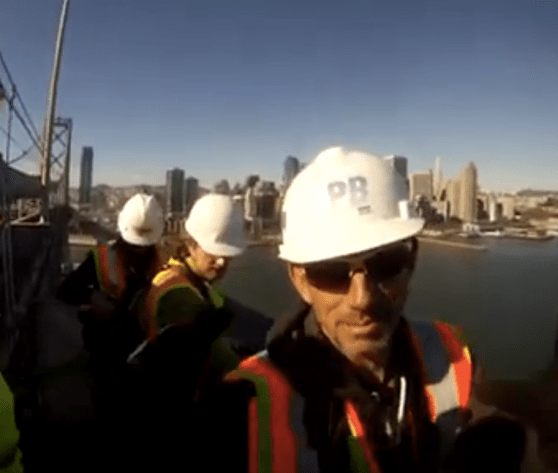‘The bridge is really a big-ass display’
The bridge has already had an impact on Robert Stephens. He’s the founder of Geek Squad and served as the chief technology officer of Best Buy for 10 years. Before that, he studied at the Art Institute of Chicago and dropped out to build computers. When he first heard about the Bay Lights Project, he was instantly fascinated and decided to get involved.
“I have always gone back-and-forth between art and technology, and these two worlds have traditionally been separate,” Stephens said. “This project represents a bridge between art and technology and the civics. It will unify the city in a way that nothing else has. I believe when they light that thing up tonight, the city will fall in love with it. I can’t wait to hear all the stories, memories and moments people have while looking at the lights from different points.”
Last week, Davis invited Stephens to see the Bay Bridge from a perspective few others have — the top. Wearing a GoPro camera, he climbed the bridge to check out all the physical bits and pieces that connect the lights to the software governing them. Fundamentally, the bridge is “a big-ass display,” as Hirshberg put it that seeks to bring people together rather than separating them.
“Mobile technology has made us less socially connected, not more,” Hirshberg said. “We walk around staring at our cellphones and are increasingly disconnected from urban environments and each other. However, there has always been something about light in a city at night that is communal and tribal. This type of display is expansive and has to be shared. It is a great reaction to dominant technology of the day.”
The Internet of cities
The “Internet of things” is a major trend in the technology world right now. Displays, sensors, and monitors are infiltrating everything, so why not a bridge? However, the software powering the Bay Lights Project is not intended to provide insight on the vehicles that pass over it. Rather, it is intended to stimulate discussion about the relationship between art and technology and between people and physical things.
The work is part of the contemporary software art movement, which is just beginning to receive recognition in the art world as legitimate. Like impressionism, photography, and any type of art that introduces a transformative element, it can take a while for the establishment to express its appreciation. That said, San Francisco has historically been on the cutting-edge of techno culture, and the Bay Lights Project is an expression of that legacy.
“This is an example of really advanced technology pushing innovation forward, like a great hackathon,” Hirshberg said. “Tech art sounds scary and geeky. People don’t understand it and are not sure if it is art, but millions of people a year will think it is cool and that’s how art is formed. Look at whats going on with DJ and electronic music culture. When something innovative happens here, our innovation community knows what to do with it.”
Most of the innovation happens behind closed doors and is not immediately apparent to people walking the streets. The Bay Lights seek to make a visceral connection to technology and design a central part of the San Francisco experience. The experience changes from different vantage points and in different situations, and its supporters hope the artwork sets off waves of philosophical meanderings about art, technology, and the human experience.
But for now, let’s just watch the pretty lights.
All photos and video courtesy of the Bay Lights Project.
VentureBeat's mission is to be a digital town square for technical decision-makers to gain knowledge about transformative enterprise technology and transact. Learn More

